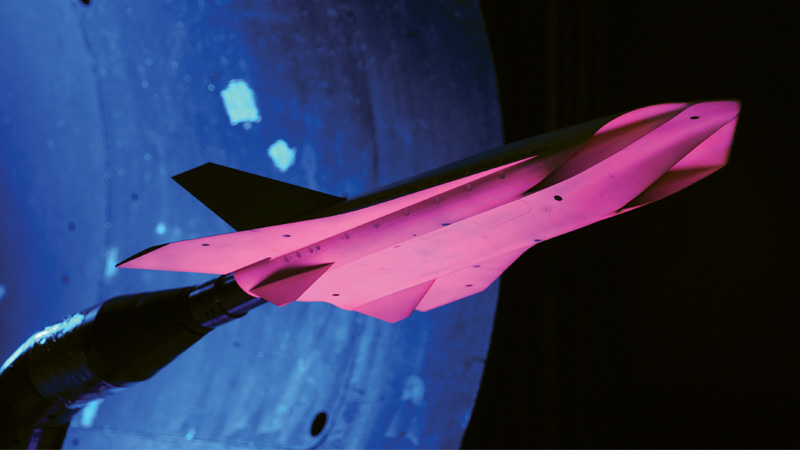Stay Up to Date
Submit your email address to receive the latest industry and Aerospace America news.
The Ground Testing Technical Committee focuses on evaluating aircraft, launch vehicles, spacecraft, structures, and engines in wind tunnels and other facilities.
Ground testing in 2016 focused on modernizing the U.S. facility infrastructure and the application of advanced test techniques in the subsonic through hypersonic flight regimes. Some of that testing included:
- Upgrades to the National Transonic Facility at NASA Langley Research Center, Virginia — These aimed to improve both data accuracy and repeatability. Increased temperature stability and force measurement accuracy of their semispan balance made this possible. Tests conducted with Lockheed Martin Skunk Works’ hybrid wing body were used to build confidence and validate existing computational fluid dynamics models of drag.
- Lockheed Martin’s Hybrid Wing-Body Future Airlifter — At the 11-foot transonic tunnel at NASA Ames Research Center, California, an investigation under contract with Boeing was performed on a 4.5 percent scale transonic truss braced wing model. A stepped model component build-up procedure collected a battery of data including force-and-moment, surface pressure, model deformation, pressure sensitive paint and surface oil flow visualization in an effort to assess drag rise data and stability and control characteristics.
Hypersonics saw a collaboration between the Arnold Engineering Development Complex in Tennessee and the U.S. Air Force Research Laboratory in Ohio as part of a Hypersonic International Flight Experimentation, or HIFEX, research program. The project is designed to advance the maturing technologies for a next-generation hypersonic cruise vehicle. Future collaborations on an axi-symmetric scramjet flow path and specific canonical geometries aimed at providing workforce revitalization are in the works as important follow-on activities in the Hypervelocity Wind Tunnel 9 facility in Maryland.
The High Enthalpy Shock Tunnel at the Japan Aerospace Exploration Agency conducted a test with a re-entry HYFLEX, or Hypersonic Flight Experiment model. Using a new preflight technique that included 16 piezoelectric-charge type accelerometers, eight pressure transducers and three onboard data recorders captured critical data to evaluate the effects of high temperature real gas effects on pitching moment and related body flap efficiency.
The Holloman High Speed Test Track in New Mexico operated by the U.S. Air Force’s 846th Test Squadron is the longest and most precisely aligned track in the world. Designed in 1964, that track has been used to simulate hypersonic flight and aerothermal testing with 240 hypersonic missions conducted to date. The test that took place on March 4 sent the sled accelerating at 633 mph, shattering the previous record of 513 mph. Efforts to conduct Mach 10 tests in the future are currently underway.
In space exploration, NASA Glenn Research Center’s Plum Brook Station near Cleveland contains the largest space environment simulation facility in the U.S. and is preparing to begin testing every element of the Orion spacecraft’s power and life support systems. A full-sized European Service Module will be used by engineers at the facility in a suite of tests. The first test will verify the mechanical movement of the solar array followed by pressure and vibration bombardment of the European Service Model’s separate elements and then as the system as a whole in the acoustic test chamber. Finally, the module will move into the mechanical vibration facility’s table to simulate the vibration experiences during launch. The tests are critical to verify the flight readiness and the structural integrity of the Orion module.
The Arnold Engineering Development Complex/National Full-Scale Aerodynamic Complex facility in Moffett Field, California, conducted complete system tests to obtain flight qualification of two separate parachute systems. The first test included two mortar deployments of the European Space Agency’s Exomars parachute. The second included 16 mortar deployments of parachutes for the NASA Joint Propulsion Laboratory’s InSIGHT stationary lander program. Both test campaigns were successful in obtaining their qualifications. ★
Stay Up to Date
Submit your email address to receive the latest industry and Aerospace America news.




